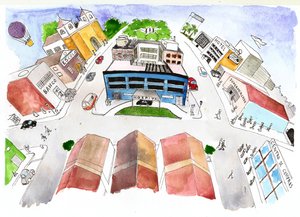Smart Cities – Part I – Sustainability for Industries and Cities – How the Technology Area Contributes to Smart Industries & Smart Cities

In the last decade we have seen radical changes in almost every way we perceive the world. Be it from an economic perspective, be it from a behavioral perspective, or from the way societies and people interact, or from technology, and now in a subject that we pay attention to, on the subject of climate change. Our constant and growing talent for economic development is now confronted with the limits imposed by the damages that a maximized productivity imposes. A dichotomy of values - partly linked to progress and partly to survival, more and more presents itself as recurring questioning to every person concerned about the future of the planet and therefore with humanity itself.
The theme of sustainability as well as that of sustainable development came to light with the increase in industrial productivity, the often-predatory use of natural resources, the use of methods and processes that prioritized immediate gains, the enthronement of a lifestyle permeated by exaggeration, waste and unconcern. The whole chain of work had been revised by the waves of industrial and labor revolution that then modified or deepened these problems. In the end they have generated in the land of the new millennium a production of greenhouse gases that now unbalance the global climate.
It seems to us that, together with the issue of social or labor inequalities, social, racial or religious conflicts, hunger and lack of water – has been a guideline of most nations around an increasingly uniform objective – the establishment of greenhouse gas emission reduction targets.
We also perceive that given the different characteristics of each nation or region of the planet, by understanding its available natural resources, the relative use of renewable resources against non-renewable sources, its energy matrix, consumption behavior and pattern of the society, more or less matured around the sustainability of the corporations of that society, will guide a certain strategy in its policy of reducing emissions. This strategy should compose with governmental and regulatory leaders in all spheres in the direct productive action or in the direction and control of sustainability practices, with the corporate leaders who restructure the productive chain of their corporation, and with each individual who seeks to reestablish their standard consumption. But it also saw independent, third-sector organizations, nongovernmental, philanthropic, and other associations that support and collaborate with all these leaderships.
In this reduction accounting, which governments gather and present at international meetings – as at the United Nations World Conferences – there are composites of combined efforts around review of industrial processes, changes in the energy matrix for clean energy use, curbing deforestation and processes (using the carbon market), use of a more sustainable logistics and consumption chain, and differentiated combinations of regional talent and deficiencies within each nation to provide intelligent processes that induce as a whole, a decrease in the production of greenhouse gases.
In large part of this strategy, the proposition of methods that relate to automation, self-regulation, use of intelligent processes, use of interdependent and communicating processes end up bringing a significant contribution to this reduction.
These methods are very commonly coming from the information technology and telecommunications industry. In fact, the set of methods themselves do not carry this possibility, but they did so in the productive development waves that we live by potentiating an entire chain of processes (productive, consumption, distribution, etc.), when they are used as tools for this transformation capacity.
Thus, the goal here is to examine how these technologies support sustainable programs, or otherwise support smart city policies in these same programs.
(To be continued)